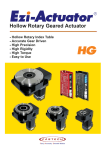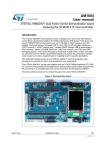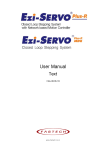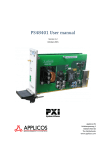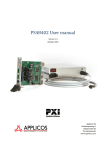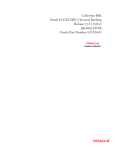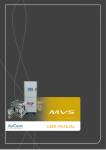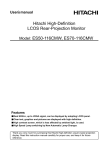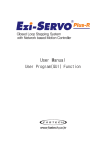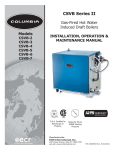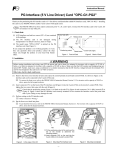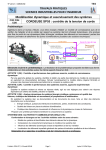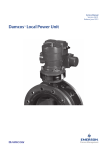Download Ezi-SERVO-BT
Transcript
$MPTFE-PPQ4UFQQJOH4ZTUFN ¿.PUPS&ODPEFS%SJWF ¿$MPTFE-PPQ4ZTUFN ¿/P(BJO5VOJOH/P)VOUJOH ¿)JHI3FTPMVUJPO'BTU3FTQPOTF ú ú ú ú $MPTFE-PPQ4UFQQJOH4ZTUFN 2 No Gain Tuning Conventional servo systems, to ensure machine performance, smoothness, positional error and low servo noise, require the adjustment of its servo’s gains as an initial crucial step. Even systems that employ auto-tuning require manual tweaking after the system is installed, especially if more that one axis are interdependent. Ezi-SERVO® employs the best characteristics of stepper and closed loop motion controls and algorithms to eliminate the need of tedious gain tuning required for conventional closed loop servo systems. This means that Ezi-SERVO® is optimized for the application and ready to work right out of the box! The Ezi-SERVO® system employs the unique characteristics of the closed loop stepping motor control, eliminating these cumbersome steps and giving the engineer a high performance servo system without wasting setup time. Ezi-SERVO® is especially well suited for low stiffness loads (for example, a belt and pulley system) that sometime require conventional servo systems to inertia match with the added expense and bulk of a gearbox. Ezi-SERVO® also performs exceptionally, even under heavy loads and high speeds! 3 No Hunting Traditional servo motor drives overshoot their position and try to correct by overshooting the opposite direction, especially in high gain applications. This is called null hunt and is especially prevalent in systems that the break away or static friction is significantly higher than the running friction. The cure is lowering the gain, which affects accuracy or using Ezi-SERVO® Motion Control System! Ezi-SERVO® utilizes the unique characteristics of stepping motors and locks itself into the desired target position, eliminating Null Hunt. This feature is especially useful in applications such as nanotech manufacturing, semiconductor fabrication, vision systems and ink jet printing in which system oscillation and vibration could be a problem. Complete stop 1 Closed Loop System Ezi-SERVO® is an innovative closed loop stepping motor and controller that utilizes a high-resolution motor mounted encoder to constantly monitor the motor shaft position. The encoder feedback feature allows the Ezi-SERVO® to update the current motor shaft position information every 25 micro seconds. This allows the Ezi-SERVO® drive to compensate for the loss of position, ensuring accurate positioning. For example, due to a sudden load change, a conventional stepper motor and drive could lose a step creating a positioning error and a great deal of cost to the end user! Hunting 2 4 Smooth and Accurate Ezi-SERVO® is a high-precision servo drive, using a highresolution encoder with 32,000 pulses/revolution. Unlike a conventional Microstep drive, the on-board high performance DSP (Digital Signal Processor) performs vector control and filtering, producing a smooth rotational control with minimum ripples. 5 3 High Torque Compared with common step motors and drives, Ezi-SERVO® motion control systems can maintain a high torque state over relatively long period of time. This means that Ezi-SERVO continuously operates without loss of position under 100% of the load. Unlike conventional Microstep drives, Ezi-SERVO® exploits continuous high-torque operation during high-speed motion due to its innovative optimum current phase control. Fast Response Similar to conventional stepping motors, Ezi-SERVO® instantly synchronizes with command pulses providing fast positional response. Ezi-SERVO® is the optimum choice when zerospeed stability and rapid motions within a short distance are required. Traditional servo motor systems have a natural delay between the commanding input signals and the resultant motion because of the constant monitoring of the current position, necessitating in a waiting time until it settles, called settling time. 6 7 High Resolution The unit of the position command can be divided precisely. (Max. 20,000 pulses/revolution) 8 High Speed The Ezi-SERVO® functions well at high speed without the loss of Synchronism or positioning error. Ezi-SERVO®’s ability of continuous monitoring of current position enables the stepping motor to generate high-torque, even under a 100% load condition. ● Part Numbering ● Combination List of Ezi-SERVO-BT Ezi-SERVO-BT-42S-A-□ Unit Part Number Ezi-SERVO-BT-42S-A Closed Loop Stepping System Name Ezi-SERVO-BT-42S-B Motor Flange Size Ezi-SERVO-BT-42M-B 42 : 42mm 56 : 56mm 60 : 60mm Ezi-SERVO-BT-42M-A Ezi-SERVO-BT-42L-A Ezi-SERVO-BT-42L-B Ezi-SERVO-BT-42XL-A Ezi-SERVO-BT-42XL-B Motor Length S : M: L : XL: Single Middle Large Extra Large Encoder Resolution A : 10,000/Rev. B : 20,000/Rev. Ezi-SERVO-BT-56S-A Ezi-SERVO-BT-56S-B Ezi-SERVO-BT-56M-A Ezi-SERVO-BT-56M-B Ezi-SERVO-BT-56L-A Ezi-SERVO-BT-56L-B Ezi-SERVO-BT-60S-A Ezi-SERVO-BT-60S-B Ezi-SERVO-BT-60M-A Ezi-SERVO-BT-60M-B User Code Ezi-SERVO-BT-60L-A Ezi-SERVO-BT-60L-B ● Advantages over Open-loop Control Stepping Drive 1. Reliable positioning without loss of synchronism. 2. Holding stable position and automatically recovering to the original position even after experiencing positioning error due to external forces, such as mechanical vibration or vertical positional holding. 3. Ezi-SERVO® utilizes 100% of the full range of rated motor torque, contrary to a conventional open-loop stepping driver that can use up to 50% of the rated motor torque due to the loss of synchronism. 4. Capability to operate at high speed due to load-dependant current control, open-loop stepper drivers use a constant current control at all speed ranges without considering load variations. ● Advantages over Servo Motor Controller 1. No gain tuning (Automatic adjustment of gain in response to a load change.) 2. Maintains the stable holding position without oscillation after completing positioning. 3. Fast positioning due to the independent control by on-board DSP. 4. Continuous operation during rapid short-stroke movement due to instantaneous positioning. 4 ● Specifications Input Voltage Control Method 24VDC ±10% Closed loop control with 32bit DSP Operating Condition Current Consumption Max 500mA (Except motor current) Ambient Temperature Humidity Vib. Resist. In Use : 0~50℃ In Storage : -20~70℃ In Use : 35~85% In Storage : 10~90% 0.5G Rotation Speed 0~3000rpm 10,000/Rev. Encoder model : 500 1,000 1,600 2,000 3,600 5,000 6,400 7,200 10,000 Resolution(P/R) 20,000/Rev. Encoder model : 500 1,000 1,600 2,000 3,600 5,000 6,400 7,200 10,000 20,000 (Selectable with Rotary switch) Function Max. Input Pulse 500KHz (Duty 50%) Frequency Protection Functions Over current, Over speed, Position tracking error, Over load, Over temperature, Over regenerated voltage, Motor connect error, Encoder connect error, Motor voltage error, In-Position error, System error, ROM error, Position overflow error In-Position Selection 0~F (Selectable with Rotary switch) Position Gain Selection 0~F (Selectable with Rotary switch) Pulse Input Method 1-Pulse / 2-Pulse (Selectable with DIP switch) I/O Signals Speed/Position Pulse train input Control Command 5 Input Signals Output Signals Position command pulse, Servo On/Off, Alarm reset (Photocoupler input) In-Position, Alarm (Photocoupler output) Encoder signal (A+, A-, B+, B-, Z+, Z-, 26C31 of Equivalent) (Line Driver output) 42 ● Motor Specifications M O D E L DRIVE METHOD NUMBER OF PHASES VOLTAGE CURRENT per PHASE RESISTANCE per PHASE INDUCTANCE per PHASE HOLDING TORQUE ROTOR INERTIA WEIGHTS LENGTH (L) 3mm ALLOWABLE 8mm OVERHUNG LOAD (DISTANCE FROM 13mm END OF SHAFT) 18mm ALLOWABLE THRUST LOAD INSULATION RESISTANCE INSULATION CLASS OPERATING TEMPERATURE UNIT Ezi-SERVO-BT Ezi-SERVO-BT Ezi-SERVO-BT Ezi-SERVO-BT 42S Series 42M Series 42L Series 42XL Series ------VDC A Ohm mH N·m g·㎠ g mm N N MOhm ---℃ BI-POLAR 2 3.36 1.2 2.8 2.5 0.32 35 220 33 22 26 33 46 BI-POLAR BI-POLAR 2 2 4.32 4.56 1.2 1.2 3.6 3.8 7.2 8 0.44 0.5 54 77 280 350 39 47 22 22 26 26 33 33 46 46 Lower than motor weight 100min. (at 500VDC) CLASS B (130℃) 0 to 55 BI-POLAR 2 7.2 1.2 6 15.6 0.8 114 500 59 22 26 33 46 ● Motor Dimension [mm] and Torque Characteristics 6 ※Measured Condition Motor Voltage = 24VDC Motor Current = Rated Current (Refer to Motor Specification) Drive = Ezi-SERVO-BT ● Motor Specifications M O D E L DRIVE METHOD NUMBER OF PHASES VOLTAGE CURRENT per PHASE RESISTANCE per PHASE INDUCTANCE per PHASE HOLDING TORQUE ROTOR INERTIA WEIGHTS LENGTH (L) 3mm ALLOWABLE 8mm OVERHUNG LOAD (DISTANCE FROM 13mm END OF SHAFT) 18mm ALLOWABLE THRUST LOAD INSULATION RESISTANCE INSULATION CLASS OPERATING TEMPERATURE UNIT ------VDC A Ohm mH N·m g·㎠ g mm N N MOhm ---℃ 56 Ezi-SERVO-BT 56S Series Ezi-SERVO-BT 56M Series Ezi-SERVO-BT 56L Series BI-POLAR 2 1.56 3 0.52 1 0.64 120 500 46 52 65 85 123 BI-POLAR 2 2.1 3 0.54 2 1 200 700 54 52 65 85 123 Lower than motor weight 100min. (at 500VDC) CLASS B (130℃) 0 to 55 BI-POLAR 2 2.7 3 0.9 3.8 2 480 1150 80 52 65 85 123 ● Motor Dimension [mm] and Torque Characteristics * 7 ※Measured Condition Input Voltage = 24VDC Motor Current = Rated Current (Refer to Motor Specification) Drive = Ezi-SERVO-BT * : There are 2 kinds size of front shaft diameter for Ezi-SERVO-BT-56 series as Φ6.35 and Φ8.0. ● Motor Specifications M O D E L DRIVE METHOD NUMBER OF PHASES VOLTAGE CURRENT per PHASE RESISTANCE per PHASE INDUCTANCE per PHASE HOLDING TORQUE ROTOR INERTIA WEIGHTS LENGTH (L) 3mm ALLOWABLE 8mm OVERHUNG LOAD (DISTANCE FROM 13mm END OF SHAFT) 18mm ALLOWABLE THRUST LOAD INSULATION RESISTANCE INSULATION CLASS OPERATING TEMPERATURE UNIT ------VDC A Ohm mH N·m g·㎠ g mm N N MOhm ---℃ 60 Ezi-SERVO-BT 60S Series Ezi-SERVO-BT 60M Series Ezi-SERVO-BT 60L Series BI-POLAR 2 1.52 4 0.38 0.64 0.88 140 600 46 70 87 114 165 BI-POLAR 2 1.56 4 0.39 1.2 1.28 320 900 56 70 87 114 165 Lower than motor weight 100min. (at 500VDC) CLASS B (130℃) 0 to 55 BI-POLAR 2 2.6 4 0.65 2.4 2.4 800 1600 90 70 87 114 165 ● Motor Dimension [mm] and Torque Characteristics 8 ※Measured Condition Input Voltage = 24VDC Motor Current = Rated Current (Refer to Motor Specification) Drive = Ezi-SERVO-BT ● Setting and Operating Position Controller Gain(SW2) Resolution setting(SW3) In-Position value setting(SW4) RS-232C connection(CN3) Power connection(CN2) Input/Output connection(CN1) Pulse input selection switch(SW1) Status Monitor LED ◆ Protection function and LED flash times When Alarm occurs, can recognize main reason of alarming thru by LED flash times. Times 1 2 3 Conditions Over current Over speed Position tracking error The current through power devices in inverter exceeds the limit value Motor speed exceed 3,000rpm Position error value is higher than 90˚ in motor run state The motor is continuously operated more than 5 second under Over load a load exceeding the max. torque Over temperature Inside temperature of drive exceeds 55℃ Over regeneratived voltage Back-EMF more than 50V Motor connect error The power is ON without connection of the motor cable to drive Encoder connect error Cable connection error with Encoder connector in drive Motor voltage error Motor voltage is less than 20V In-Position error After operation is finished, a position error occurs System error Error occurs in drive system ROM error Error occurs in parameter storage device(ROM) Position overflow error Position error value is higher than 90˚ in motor stop state 4 5 6 7 8 9 10 11 12 15 9 Protection Alarm LED flash (ex : Position tracking error) 1. Pulse input and motor direction selection switch(SW1) Indication Switch Name Functions 2P/1P Selecting pulse input mode Selectable 1-Pulse input mode or 2-Pulse input mode as Pulse input signal. ON : 1-Pulse mode OFF : 2-Pulse mode ※Default : 2-Pulse mode 2. Resolution selection switch(SW3) The Number of pulse per revolution. Position Pulse/Rotation Position 0 1 2 3 4 500*1 500 1,000 1,600 2,000 5 6 7 8 9 *1 : Resolution value depend on encoder type. *2 : Default = 10,000 Pulse/Rotation 3,600 5,000 6,400 7,200 10,000*2 3. Position Controller Gain Selection switch(SW2) 7. Input/Output signal(CN1) The Position Controller Gain Switch allows for the correction of the motor position deviation after stopping caused by load and friction. Depending on the motor load, the user may have to select a different gain position to stabilize and to correct positional error quickly. To tune the controller 1. Set the switch to “0” position. 2. Start to rotate the switch until system becomes stable. 3. Rotate the switch +/- 1~2 position to reach better performance. Position Time Constant of the Proportional Gain 1 * Integral part 0 1 2 *23 4 5 6 7 8 9 A B C D E F 1 1 1 1 1 1 2 2 2 2 2 3 3 3 3 3 1 2 3 4 5 6 1 2 3 4 5 1 2 3 4 5 NO. Function I/O 1 2 3 4 5 6 7 8 9 10 11 12 13 14 15 16 17 18 19 20 CW+(Pulse+) CW-(Pulse-) CCW+(Dir+) CCW-(Dir-) A+ AB+ BZ+ ZAlarm In-Position Servo On/Off Alarm Reset NC BRAKE+ BRAKESignal-GND 24VDC GND 24VDC Input Input Input Input Output Output Output Output Output Output Output Output Input Input ---Output Output Output Input Input 20 2 19 1 *1 : Value in the columns are in relative units. They only show the parameter changes depending on the switch’s position. *2 : Default = 3 4. In-Position Value Setting switch(SW4) ● GUI(Graphic User Interface) To select the output condition of In-Position signal. In-Position output signal is generated when the pulse number of positional error is lower than selected In-Position value set by this switch after positioning command is executed. Position *10 1 2 3 4 5 6 7 In-Position Value[Pulse] In-Position Value[Pulse] Position Fast Response Accurate Response 0 1 2 3 4 5 6 7 8 9 A B C D E F 0 1 2 3 4 5 6 7 *1 : Default = 0 ※Please refer to User Manual for setup. 5. Power Connector(CN2) NO. Function 1 2 24VDC ±10% GND 2 1 6. RS-232C Communication(CN3) Communication Port to set parameter by computer. BaudRate is 115200bps. To set parameter, please use included GUI program. NO. Function 1 2 3 Rx Tx GND 1 2 3 10 ● System Configuration Type Power Cable Signal Cable Standard Length Max. Length 2m 20m 1. Cable Option 11 ①Signal Cable ③RS-232C Cable Available to connect between Control System and Ezi-SERVO-BT. Cable to connect Ezi-SERVO-BT series and computer. Please use this cable to change parameter as like resolution of Drive and Stop current. Item Length[m] Remark CSVB-S-□□□F CSVB-S-□□□M □□□ □□□ Normal Cable Robot Cable □ is for Cable Length. The unit is 1m and Max. 20m length. ②Power Cable Available to connect between Power and Ezi-SERVO-BT. Item Length[m] Remark CSVA-P-□□□F CSVA-P-□□□M □□□ □□□ Normal Cable Robot Cable □ is for Cable Length. The unit is 1m and Max. 20m length. Item Length[m] Remark CBTB-C-□□□F □□□ Normal Cable □ is for Cable Length. The unit is 1m and Max. 15m length. 2. Option ④FAS-UCR(USB to RS-232C Converter) Item Comm. Speed Comm. Distance Connector Type IP Address IRQ Number Dimension Weight Power Specification 115.2Kbps default USB : Max. 5m RS-232C : Max. 15m USB : USB Standard RS-232C : DB9 Femail Automatic Setting Automatic Setting 50X69X23mm 31g USB self power (No need External power) USB Cable Item Length[m] Remark CGNR-U-002F CGNR-U-003F CGNR-U-005F 2 3 5 Normal Cable 3. Connector for Cabling ITEM Power Connector (CN2) Signal Connector (CN1) RS-232C Connetor (CN3) Specification Maker Terminal Block AKZ1550/2F-3.81 PTR Housing 501646-2000 MOLEX Terminal 501648-1000(AWG 26~28) MOLEX Housing 33507-0300 MOLEX Terminal 50212-8100 MOLEX ※These connectors are serviced together with Ezi-SERVO-BT except when purchasing option cables. ※Above connector is the most suitable product for Ezi-SERVO-BT. Another equivalent connector can be used. 12 ● External Wiring Diagram 13 ● Control Signal input/output Description 1 Input signal Input signals of the drive are all photocoupler protected. The signal shows the status of internal photocouplers [ON: conduction], [OFF: Non-conduction], not displaying the voltage levels of the signal. ◆ Servo On/Off Input This input can be used only to adjust the position by manually moving the motor shaft from the load-side. By setting the signal [ON], the driver cuts off the power supply to the motor. Then, one can manually adjust output position. When setting the signal back to [OFF], the driver resumes the power to the motor and recovers the holding torque. When driving a motor, one needs to set the signal [OFF]. CW(Pin:1,2), CCW(Pin:3,4) ◆ CW, CCW Input Alarm Reset (Pin:14) Servo On/Off(Pin:13) This signal can be used to receive a positioning pulse command from a user host motion controller. The user can select 1-pulse input mode or 2-pulse input mode (refer to switch No.1, SW1). The input schematic of CW, CCW is designed for 5V TTL level. When using 5V level as an input signal, the resistor Rx is not used and connect to the driver directly. When the level of input signal is more than 5V, Rx resistor is required. If the resistor is absent, the drive will be damaged! If the input signal level is 12V, Rx value is 2.2Kohm and 24V, Rx value is 4.7Kohm. 2 ◆ Alarm Reset Input When a protection mode has been activated, a signal to this alarm reset input cancels the Alarm output. ※ By setting the alarm reset input signal [ON], cancel the Alarm output. Before cancel the Alarm output, have to remove the source of alarm. Output signals Output signals from the driver are photocoupler protected: Alarm, In-Position and the Line Driver Outputs (encoder signal). In the case of photocoupler outputs, the signal indicates the status of internal photocouplers [ON: conduction], [OFF: Nonconduction], not displaying the voltage levels of the signal. ◆ In-Position Output In-Position signal is [ON] when positioning is completed. This signal is [ON] when the motor position error is within the value set by the switch SW4. 14 Alarm(Pin:11), In-Position(Pin:12) Encoder signal (Pin:5,6,7,8,9,10) ◆ Alarm Output The Alarm output indicates [ON] when the driver is in a normal operation. If a protection mode has been activated, it goes [OFF]. A host controller needs to detect this signal and stop sending a motor driving command. When the driver detects an abnormal operation such as overload or over current of the motor, it sets the Alarm output to [OFF], flashes the Alarm LED, disconnect the power to a motor and stops the motor simultaneously. [Caution] Only at the Alarm output port, the photocoupler isolation is in reverse. When the driver is in normal operation the Alarm output is [ON]. On the contrary when the driver is in abnormal operation that start protection mode, the Alarm output is [OFF]. ◆ Encoder signal Output The encoder signal is a line driver output. This can be used to confirm the stop position. ⓒCopyright 2010 FASTECH Co,. Ltd. All Rights Reserved. Oct 14, 2010 Rev.05
















